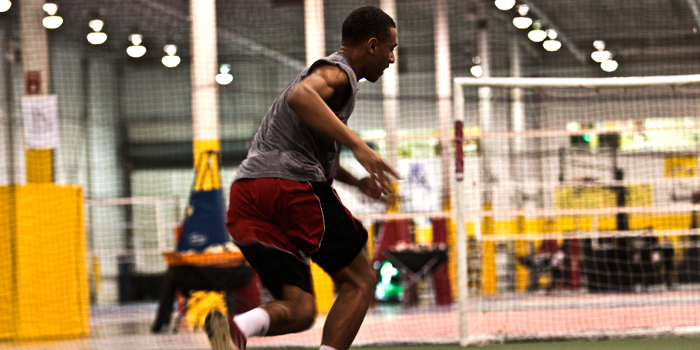
There are a lot of ideas on what dynamic work should be. In regards to powerlifting, it is described as lifting a non-maximal load with the greatest speed possible (focusing on compensatory acceleration). This means that you must apply as much force as possible to the barbell, i.e. pushing as hard and as fast as you can in the concentric phase of the lift. The set and rep scheme that goes with this works well for a small group of powerlifters, but what about in a team setting? Is doing 8x2 of box squats with chains really beneficial when training a large group of athletes? Some will argue yes and some will argue no. I'll argue maybe. When developing a training program for athletes, you have to look at what will give you the best results in the least amount of time and won't require too much time spent teaching the movements. It isn't always about one movement being better than another. You have to factor in aspects like time management, athlete experience level, and learning ability. For example a lot of strength coaches love the olympic lifts because they "teach speed, explosiveness, and triple extension." Well, I bet 90% of the athletes doing these cleans with a sub-maximal load aren't reaching triple extension at all. Not to mention that any lift can be done explosively. As long as the lift is being done with sub-maximal weights in an explosive manner, you can say it is teaching explosiveness.
Olympic lifts take a long, long time to teach. Most athletes aren't strong enough to perform them because of a lack of hamstring, glute, or low back strength. These style of lifts put too much unnecessary strain on the wrist, elbows, and shoulders, without giving the performance benefits to justify it. We want to decrease injuries, not produce them. So, back to the 8x2 of box squats with chains for dynamic work. Is this the best way to increase speed. Maybe? Maybe not? I'm not sure. For a powerlifter, dynamic work is highly beneficial, but for athletes it might not be. I don't think it is, at least. There are better ways to practice speed work for your athlete. Most athletes aren't even strong enough or efficient enough to produce enough force to elicit a training effect with powerlifting style dynamic work (thank Mark Watts for that fancy sentence there). At this point you may be wondering what exactly you can use for dynamic work in athletes. Glad you asked. At The Spot we like to do things that will have a better carryover to the athlete's sport. This means that we may train a volleyball player differently than a discus thrower. Here is a list of the things we incorporate into our athletes dynamic effort training:
Olympic Lift Variations
You can use clean pulls, snatch pulls, push press/jerk, high pulls, kettlebell variations and other variations. The main issue with olympic lifting is the catch. It's what causes all the strain on the wrists, elbows, and shoulders, and what most athletes aren't able to do correctly. By eliminating the catch, your athletes will be able to harness all of the benefits of Olympic lifting without paying the cost with their joint health.
Throws
I love throws. They teach triple extension a lot more easily than Olympic lifts do. They are easier on the joints. The variations are endless. Easier to learn and fun to do. Just make sure the athletes are throwing as hard and as fast as possible, just like with speed work. Otherwise, if the ball is too heavy, you are merely doing strength work.
Jumps
Just about every sport requires an athlete to jump. Why not train it? Your options are endless and the planes in which you perform them allow you, as a coach, to be creative. You can do these in a lot of ways, including standing jumps, seated jumps, weighted variations, hurdle variations, jumping onto boxes, or jumping over boxes. The possibilities are endless.
Sprints
Sprints are very CNS intensive and extremely dynamic. Your options, again, are endless. Try various start positions and distances, and even incorporating jumps with your more advanced athletes. Make sure sprints are done at the beginning of the workout and proper rest is given. In a team setting, 30 seconds rest for one second of sprinting should be enough (more knowledge I gained from talking to Mark Watts). I know Charlie Francis preferred a few minutes per seconds, but most of the time we don’t have the training session length to devote that duration of time to recovery. Don't be afraid to get creative with these techniques by combining them. For example: jumping chest pass into a sprint, hurdle hops into a box jump, hurdle hops into a sprint, depth jump into a broad jump chest pass. Your options are endless, so keep it interesting for your athletes. The more mentally engaged they are, the better they will perform physically. The biggest thing to focus on is programming. So pay attention to volume and other stressors in your athletes life. There you have: it dynamic effort work for the athlete. We only have a small amount of time with our athletes, so we want exercises that are going to give us the biggest bang for our buck. Use their time and your time wisely.
Nic Bronkall is the Director of Athletic Development and the Internship Director at The Spot Athletics in Columbus, Ohio. He is also an avid powerlifter competing in the 242 weight class.












1 Comment